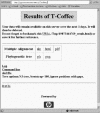Tcoffee@igs: A web server for computing, evaluating and combining multiple sequence alignments
- PMID: 12824354
- PMCID: PMC168929
- DOI: 10.1093/nar/gkg522
Tcoffee@igs: A web server for computing, evaluating and combining multiple sequence alignments
Abstract
This paper presents Tcoffee@igs, a new server provided to the community by Hewlet Packard computers and the Centre National de la Recherche Scientifique. This server is a web-based tool dedicated to the computation, the evaluation and the combination of multiple sequence alignments. It uses the latest version of the T-Coffee package. Given a set of unaligned sequences, the server returns an evaluated multiple sequence alignment and the associated phylogenetic tree. This server also makes it possible to evaluate the local reliability of an existing alignment and to combine several alternative multiple alignments into a single new one. Tcoffee@igs can be used for aligning protein, RNA or DNA sequences. Datasets of up to 100 sequences (2000 residues long) can be processed. The server and its documentation are available from: http://igs-server.cnrs-mrs.fr/Tcoffee/.
Figures


Similar articles
-
3DCoffee@igs: a web server for combining sequences and structures into a multiple sequence alignment.Nucleic Acids Res. 2004 Jul 1;32(Web Server issue):W37-40. doi: 10.1093/nar/gkh382. Nucleic Acids Res. 2004. PMID: 15215345 Free PMC article.
-
SARA-Coffee web server, a tool for the computation of RNA sequence and structure multiple alignments.Nucleic Acids Res. 2014 Jul;42(Web Server issue):W356-60. doi: 10.1093/nar/gku459. Epub 2014 Jun 27. Nucleic Acids Res. 2014. PMID: 24972831 Free PMC article.
-
The M-Coffee web server: a meta-method for computing multiple sequence alignments by combining alternative alignment methods.Nucleic Acids Res. 2007 Jul;35(Web Server issue):W645-8. doi: 10.1093/nar/gkm333. Epub 2007 May 25. Nucleic Acids Res. 2007. PMID: 17526519 Free PMC article.
-
Revisiting Evaluation of Multiple Sequence Alignment Methods.Methods Mol Biol. 2021;2231:299-317. doi: 10.1007/978-1-0716-1036-7_17. Methods Mol Biol. 2021. PMID: 33289899 Review.
-
Graphs in sequence spaces: a review of statistical geometry.Biophys Chem. 1997 Jun 30;66(2-3):111-31. doi: 10.1016/s0301-4622(97)00064-1. Biophys Chem. 1997. PMID: 9362556 Review.
Cited by
-
Structural and enzymatic characterization of the lactonase SisLac from Sulfolobus islandicus.PLoS One. 2012;7(10):e47028. doi: 10.1371/journal.pone.0047028. Epub 2012 Oct 10. PLoS One. 2012. PMID: 23071703 Free PMC article.
-
Mapping human protease-activated receptor 4 (PAR4) homodimer interface to transmembrane helix 4.J Biol Chem. 2012 Mar 23;287(13):10414-10423. doi: 10.1074/jbc.M112.341438. Epub 2012 Feb 8. J Biol Chem. 2012. PMID: 22318735 Free PMC article.
-
A discontinuous DNA glycosylase domain in a family of enzymes that excise 5-methylcytosine.Nucleic Acids Res. 2011 Mar;39(4):1473-84. doi: 10.1093/nar/gkq982. Epub 2010 Oct 29. Nucleic Acids Res. 2011. PMID: 21036872 Free PMC article.
-
Computational enzyme design approaches with significant biological outcomes: progress and challenges.Comput Struct Biotechnol J. 2012 Oct 17;2:e201209007. doi: 10.5936/csbj.201209007. eCollection 2012. Comput Struct Biotechnol J. 2012. PMID: 24688648 Free PMC article. Review.
-
OrthoSelect: a protocol for selecting orthologous groups in phylogenomics.BMC Bioinformatics. 2009 Jul 16;10:219. doi: 10.1186/1471-2105-10-219. BMC Bioinformatics. 2009. PMID: 19607672 Free PMC article.
References
MeSH terms
LinkOut - more resources
Full Text Sources
Other Literature Sources

